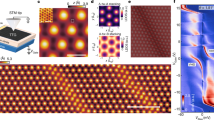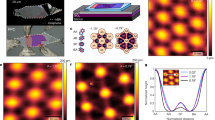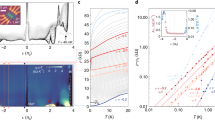Abstract
The emergence of superconductivity and correlated insulators in magic-angle twisted bilayer graphene (MATBG) has raised the intriguing possibility that its pairing mechanism is distinct from that of conventional superconductors1,2,3,4, as described by the Bardeen–Cooper–Schrieffer (BCS) theory. However, recent studies have shown that superconductivity persists even when Coulomb interactions are partially screened5,6. This suggests that pairing in MATBG might be conventional in nature and a consequence of the large density of states of its flat bands. Here we combine tunnelling and Andreev reflection spectroscopy with a scanning tunnelling microscope to observe several key experimental signatures of unconventional superconductivity in MATBG. We show that the tunnelling spectra below the transition temperature Tc are inconsistent with those of a conventional s-wave superconductor, but rather resemble those of a nodal superconductor with an anisotropic pairing mechanism. We observe a large discrepancy between the tunnelling gap ΔT, which far exceeds the mean-field BCS ratio (with 2ΔT/kBTc ~ 25), and the gap ΔAR extracted from Andreev reflection spectroscopy (2ΔAR/kBTc ~ 6). The tunnelling gap persists even when superconductivity is suppressed, indicating its emergence from a pseudogap phase. Moreover, the pseudogap and superconductivity are both absent when MATBG is aligned with hexagonal boron nitride. These findings and other observations reported here provide a preponderance of evidence for a non-BCS mechanism for superconductivity in MATBG.
This is a preview of subscription content, access via your institution
Access options
Access Nature and 54 other Nature Portfolio journals
Get Nature+, our best-value online-access subscription
$29.99 / 30 days
cancel any time
Subscribe to this journal
Receive 51 print issues and online access
$199.00 per year
only $3.90 per issue
Buy this article
- Purchase on Springer Link
- Instant access to full article PDF
Prices may be subject to local taxes which are calculated during checkout





Similar content being viewed by others
Data availability
The data that support the findings of this study are available at https://doi.org/10.5281/zenodo.5722484.
References
Cao, Y. et al. Unconventional superconductivity in magic-angle graphene superlattices. Nature 556, 43–50 (2018).
Yankowitz, M. et al. Tuning superconductivity in twisted bilayer graphene. Science 363, 1059–1064 (2019).
Lu, X. et al. Superconductors, orbital magnets and correlated states in magic-angle bilayer graphene. Nature 574, 653–657 (2019).
Cao, Y. et al. Correlated insulator behaviour at half-filling in magic-angle graphene superlattices. Nature 556, 80–84 (2018).
Saito, Y., Ge, J., Watanabe, K., Taniguchi, T. & Young, A. F. Independent superconductors and correlated insulators in twisted bilayer graphene. Nat. Phys. 16, 926–930 (2020).
Stepanov, P. et al. Untying the insulating and superconducting orders in magic-angle graphene. Nature 583, 375–378 (2020).
Bardeen, J. Electron-phonon interactions and superconductivity. Science 181, 1209–1214 (1973).
Damascelli, A., Hussain, Z. & Shen, Z.-X. Angle-resolved photoemission studies of the cuprate superconductors. Rev. Mod. Phys. 75, 473–541 (2003).
Fischer, Ø., Kugler, M., Maggio-Aprile, I., Berthod, C. & Renner, C. Scanning tunneling spectroscopy of high-temperature superconductors. Rev. Mod. Phys. 79, 353–419 (2007).
Isobe, H., Yuan, N. F. Q. & Fu, L. Unconventional superconductivity and density waves in twisted bilayer graphene. Phys. Rev. X 8, 041041 (2018).
Liu, C.-C., Zhang, L.-D., Chen, W.-Q. & Yang, F. Chiral spin density wave and d + id superconductivity in the magic-angle-twisted bilayer graphene. Phys. Rev. Lett. 121, 217001 (2018).
Kennes, D. M., Lischner, J. & Karrasch, C. Strong correlations and d + id superconductivity in twisted bilayer graphene. Phys. Rev. B 98, 241407 (2018).
Wu, F., MacDonald, A. H. & Martin, I. Theory of phonon-mediated superconductivity in twisted bilayer graphene. Phys. Rev. Lett. 121, 257001 (2018).
Lian, B., Wang, Z. & Bernevig, B. A. Twisted bilayer graphene: a phonon-driven superconductor. Phys. Rev. Lett. 122, 257002 (2019).
Wong, D. et al. A modular ultra-high vacuum millikelvin scanning tunneling microscope. Rev. Sci. Instrum. 91, 023703 (2020).
Kerelsky, A. et al. Maximized electron interactions at the magic angle in twisted bilayer graphene. Nature 572, 95–100 (2019).
Choi, Y. et al. Electronic correlations in twisted bilayer graphene near the magic angle. Nat. Phys. 15, 1174–1180 (2019).
Jiang, Y. et al. Charge order and broken rotational symmetry in magic-angle twisted bilayer graphene. Nature 573, 91–95 (2019).
Xie, Y. et al. Spectroscopic signatures of many-body correlations in magic-angle twisted bilayer graphene. Nature 572, 101–105 (2019).
Wong, D. et al. Cascade of electronic transitions in magic-angle twisted bilayer graphene. Nature 582, 198–202 (2020).
Zondiner, U. et al. Cascade of phase transitions and Dirac revivals in magic-angle graphene. Nature 582, 203–208 (2020).
Nuckolls, K. P. et al. Strongly correlated Chern insulators in magic-angle twisted bilayer graphene. Nature 588, 610–615 (2020).
Choi, Y. et al. Interaction-driven band flattening and correlated phases in twisted bilayer graphene. Nat. Phys. https://doi.org/10.1038/s41567-021-01359-0 (2021).
Saito, Y. et al. Isospin Pomeranchuk effect in twisted bilayer graphene. Nature 592, 220–224 (2021).
Rozen, A. et al. Entropic evidence for a Pomeranchuk effect in magic-angle graphene. Nature 592, 214–219 (2021).
Rodan-Legrain, D. et al. Highly tunable junctions and non-local Josephson effect in magic-angle graphene tunnelling devices. Nat. Nanotechnol. 16, 769–775 16, 769–775 (2021).
Deutscher, G. Andreev–Saint-James reflections: a probe of cuprate superconductors. Rev. Mod. Phys. 77, 109–135 (2005).
Dubouchet, T. et al. Collective energy gap of preformed Cooper pairs in disordered superconductors. Nat. Phys. 15, 233–236 (2019).
Blonder, G. E., Tinkham, M. & Klapwijk, T. M. Transition from metallic to tunneling regimes in superconducting microconstrictions: excess current, charge imbalance, and supercurrent conversion. Phys. Rev. B 25, 4515–4532 (1982).
Randeria, M., Trivedi, N., Moreo, A. & Scalettar, R. T. Pairing and spin gap in the normal state of short coherence length superconductors. Phys. Rev. Lett. 69, 2001–2004 (1992).
Serlin, M. et al. Intrinsic quantized anomalous Hall effect in a moiré heterostructure. Science 367, 900–903 (2020).
Sharpe, A. L. et al. Emergent ferromagnetism near three-quarters filling in twisted bilayer graphene. Science 365, 605–608 (2019).
Hunt, B. et al. Massive Dirac fermions and Hofstadter butterfly in a van der Waals heterostructure. Science 340, 1427–1430 (2013).
Shi, J., Zhu, J. & MacDonald, A. H. Moiré commensurability and the quantum anomalous Hall effect in twisted bilayer graphene on hexagonal boron nitride. Phys. Rev. B 103, 075122 (2021).
Zhang, Y.-H., Mao, D. & Senthil, T. Twisted bilayer graphene aligned with hexagonal boron nitride: anomalous Hall effect and a lattice model. Phys. Rev. Res. 1, 033126 (2019).
He, M. et al. Symmetry breaking in twisted double bilayer graphene. Nat. Phys. 17, 26–30 (2021).
Khalaf, E., Chatterjee, S., Bultinck, N., Zaletel, M. P. & Vishwanath, A. Charged skyrmions and topological origin of superconductivity in magic-angle graphene. Sci. Adv. 7, eabf5299 (2021).
Park, J. M., Cao, Y., Watanabe, K., Taniguchi, T. & Jarillo-Herrero, P. Tunable strongly coupled superconductivity in magic-angle twisted trilayer graphene. Nature 590, 249–255 (2021).
Hao, Z. et al. Electric field–tunable superconductivity in alternating-twist magic-angle trilayer graphene. Science 371, 1133–1138 (2021).
Goll, G., Löhneysen, H. V., Yanson, I. K. & Taillefer, L. Anisotropy of point-contact spectra in the heavy-fermion superconductor UPt3. Phys. Rev. Lett. 70, 2008–2011 (1993).
Laube, F., Goll, G., Eschrig, M., Fogelström, M. & Werner, R. Excess current in superconducting Sr2RuO4. Phys. Rev. B 69, 014516 (2004).
Khalaf, E., Bultinck, N., Vishwanath, A. & Zaletel, M. P. Soft modes in magic angle twisted bilayer graphene. Preprint at https://arxiv.org/abs/2009.14827v2 (2020).
Millis, A. J., Sachdev, S. & Varma, C. M. Inelastic scattering and pair breaking in anisotropic and isotropic superconductors. Phys. Rev. B 37, 4975–4986 (1988).
Zhang, Y. et al. Giant phonon-induced conductance in scanning tunnelling spectroscopy of gate-tunable graphene. Nat. Phys. 4, 627–630 (2008).
Hapala, P. et al. Mechanism of high-resolution STM/AFM imaging with functionalized tips. Phys. Rev. B 90, 085421 (2014).
Stroscio, J. A. & Celotta, R. J. Controlling the dynamics of a single atom in lateral atom manipulation. Science 306, 242–247 (2004).
Wolter, B. et al. Spin friction observed on the atomic scale. Phys. Rev. Lett. 109, 116102 (2012).
Daghero, D. & Gonnelli, R. S. Probing multiband superconductivity by point-contact spectroscopy. Supercond. Sci. Technol. 23, 043001 (2010).
Kim, K. et al. Van der Waals heterostructures with high accuracy rotational alignment. Nano Lett. 16, 1989–1995 (2016).
Acknowledgements
We thank P. Jarillo-Herrero, A. H. MacDonald and S. A. Kivelson for helpful discussions. We thank C.-L. Chiu, G. Farahi and H. Ding for helpful technical discussions. This work was primarily supported by the Gordon and Betty Moore Foundation’s EPiQS initiative grant GBMF9469 and DOE-BES grant DE-FG02-07ER46419 to A.Y. Other support for the experimental work was provided by NSF-MRSEC through the Princeton Center for Complex Materials NSF-DMR- 2011750 and NSF-DMR-1904442, ExxonMobil through the Andlinger Center for Energy and the Environment at Princeton, and the Princeton Catalysis Initiative. A.Y. acknowledges the hospitality of the Aspen Center for Physics, which is supported by the National Science Foundation grant PHY-1607611, and Trinity College, Cambridge, UK, where part of this work was carried out with the support of, in part, a QuantEmX grant from ICAM and the Gordon and Betty Moore Foundation through the grant GBMF9616. K.W. and T.T. acknowledge support from the Elemental Strategy Initiative conducted by the MEXT, Japan, grant JPMXP0112101001, and JSPS KAKENHI grants 19H05790 and JP20H00354.
Author information
Authors and Affiliations
Contributions
M.O., K.P.N., D.W. and A.Y. designed the experiment. M.O., D.W. and K.P.N. fabricated the devices used for the study. M.O., K.P.N., D.W. and R.L.L. carried out STM/STS and PCS measurements, with invaluable input from X.L. on the latter. M.O., D.W. and K.P.N. performed the data analysis. K.W. and T.T. synthesized the hBN crystals. All authors discussed the results and contributed to the writing of the manuscript.
Corresponding author
Ethics declarations
Competing interests
The authors declare no competing interests.
Additional information
Peer review information Nature thanks Dante Kennes and the other, anonymous, reviewer(s) for their contribution to the peer review of this work.
Publisher’s note Springer Nature remains neutral with regard to jurisdictional claims in published maps and institutional affiliations.
Supplementary information
Supplementary Information
This file contains Supplementary Sections A–L, including text and data, tables and Supplementary Figs. 1–16. See contents page for details.
Rights and permissions
About this article
Cite this article
Oh, M., Nuckolls, K.P., Wong, D. et al. Evidence for unconventional superconductivity in twisted bilayer graphene. Nature 600, 240–245 (2021). https://doi.org/10.1038/s41586-021-04121-x
Received:
Accepted:
Published:
Issue Date:
DOI: https://doi.org/10.1038/s41586-021-04121-x
This article is cited by
-
Terahertz linear/non-linear anomalous Hall conductivity of moiré TMD hetero-nanoribbons as topological valleytronics materials
Scientific Reports (2024)
-
Test for BCS-BEC crossover in the cuprate superconductors
npj Quantum Materials (2024)
-
Vestigial singlet pairing in a fluctuating magnetic triplet superconductor and its implications for graphene superlattices
Nature Communications (2024)
-
Imaging moiré excited states with photocurrent tunnelling microscopy
Nature Materials (2024)
-
Tuning commensurability in twisted van der Waals bilayers
Nature (2024)
Comments
By submitting a comment you agree to abide by our Terms and Community Guidelines. If you find something abusive or that does not comply with our terms or guidelines please flag it as inappropriate.



